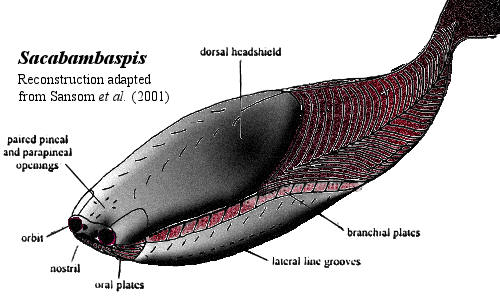Dapingian - 2
 Those Ordovician stratigraphic icons, the graptolites, made themselves conspicuous in the Dapingian Isograptus-Azygograptus radiation, some members of which are found on every continent. See, Stratigraphy. Wang et al. (2005). “The first recognizable crinoids with typically constructed cups and columnal-bearing stems, such as Dendrocrinus" also appear at about this time. Benton & Harper 1997). Conodonts began a second Ordovician radiation which would last well into the Darriwilian.
Those Ordovician stratigraphic icons, the graptolites, made themselves conspicuous in the Dapingian Isograptus-Azygograptus radiation, some members of which are found on every continent. See, Stratigraphy. Wang et al. (2005). “The first recognizable crinoids with typically constructed cups and columnal-bearing stems, such as Dendrocrinus" also appear at about this time. Benton & Harper 1997). Conodonts began a second Ordovician radiation which would last well into the Darriwilian.
The first indisputable fossils of armored jawless fishes are found in the Dapingian or latest Floian. These are the arandaspids of Bolivia and the Amadeus Basin of Australia. These are described by Sansom et al. (2001) in the following terms: "The head shields of Arandaspis and Sacabambaspis are formed from large, roughly oval, dorsal and ventral plates. These headshields are ornamented with characteristic oak-leaf shaped or tear-drop shaped tubercles. The eyes, which are surrounded by what is thought to be endoskeletal bone, and putative nostrils, are found at the extreme anterior of the head, one of the diagnostic features of the arandaspids. Arandaspids are also unique among vertebrates in possessing paired parapineal and pineal openings." ATW080301.
page uploaded ATW080301
 Those Ordovician stratigraphic icons, the graptolites, made themselves conspicuous in the Dapingian Isograptus-Azygograptus radiation, some members of which are found on every continent. See, Stratigraphy. Wang et al. (2005). “The first recognizable crinoids with typically constructed cups and columnal-bearing stems, such as Dendrocrinus" also appear at about this time. Benton & Harper 1997). Conodonts began a second Ordovician radiation which would last well into the Darriwilian.
Those Ordovician stratigraphic icons, the graptolites, made themselves conspicuous in the Dapingian Isograptus-Azygograptus radiation, some members of which are found on every continent. See, Stratigraphy. Wang et al. (2005). “The first recognizable crinoids with typically constructed cups and columnal-bearing stems, such as Dendrocrinus" also appear at about this time. Benton & Harper 1997). Conodonts began a second Ordovician radiation which would last well into the Darriwilian.